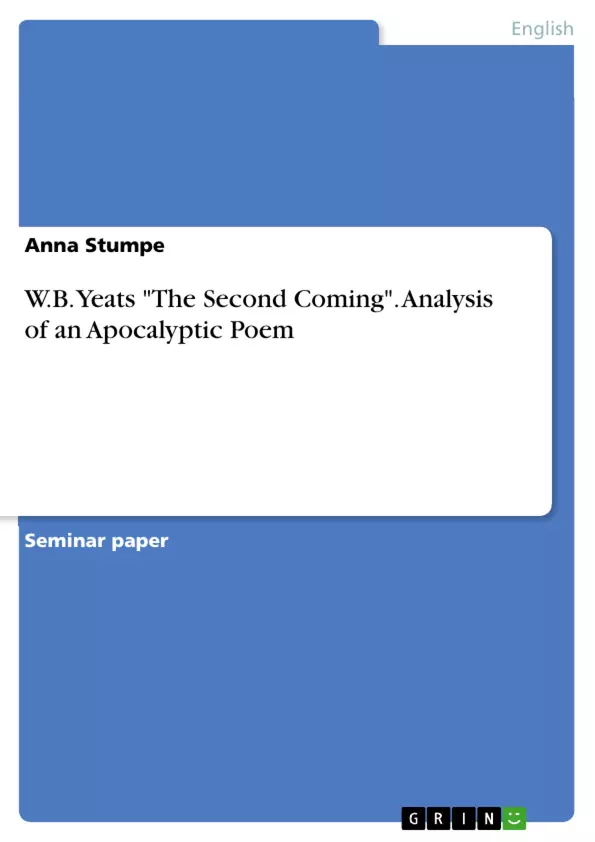William Butler Yeats did not just believe in the apocalypse, he was known for his prophetic insights and imaginative visions of the breakdown of civilization. As the Mesoamerican Long Count Calendar ends on December, 21 in 2012, many people suggest this date marks the end of the world or of human civilization. It is of a certain interest that already in the early twentieth century Yeats was concerned with this kind of apocalyptic worldview.
“The Second Coming” therefore is one of the poems that also represents his understanding of the apocalypse, which is not comparable to those who believe in the prophecy of the Mayan calendar. “For him, the apocalypse is always connected with genuine spiritual revelation [and] with vision,” as it is the literal translation of the Greek word (Howes, Kelly 2006: 52).
With this iconic, prophetic poem, he is not only regarded a public hero but also deviates from established popular beliefs, wherefore he is also named the first iconoclastic Modernist in English writing. The stunning, violent imagery and terrifying ritualistic language makes “The Second Coming” an archetypal poem about the return of history with violence. Likewise, as it was composed in 1919 and published in 1920, it represents Yeats’ immediate reaction to the political instable situation of Ireland, England and Europe after Civil War, Russian Revolution and WWI.
In consequence to that, “The Second Coming” is one the most obscure works of Yeats, hence quite difficult to understand in the first place. For this reason, firstly, this paper concentrates on the historical and political background information, which is fundamental to the poem’s understanding.
Secondly, it is this examination’s method to analyze and interpret the poem’s form, structure and images. At that, not only “The Second Coming” in its structure but also this chapter divides into three parts, from which each displays another phase in the development of the poet’s state of mind. Consequently, each line of “The Second Coming” is examined, both to explain the poet’s development and to prove the central issues of W.B. Yeats’ poem.
Eventually, this paper provides a conclusion, wherein its argumentation is summarized. This summary consequently also states the poem’s effect on the reader.
Table of Contents
- Introduction
- Background Information on W.B. Yeats and "The Second Coming"
- "The Second Coming" - Analysis and Interpretation
- Form
- Structure
- When Things Fall Apart
- When Some Revelation Is At Hand
- When A Vast Image Troubles My Sight
- Conclusion
- References
Objectives and Key Themes
This paper aims to analyze and interpret William Butler Yeats' poem "The Second Coming," focusing on its historical and political context, form, structure, and imagery. The paper explores the poem's themes of apocalypse, violence, and historical cycles, particularly within the context of early 20th century Ireland and Europe.
- The apocalyptic worldview in early 20th century Ireland
- Yeats' personal and political motivations for writing "The Second Coming"
- The poem's form, structure, and imagery as reflections of Yeats' apocalyptic vision
- The historical and cultural context of Yeats' use of the "Second Coming" motif
- The poem's broader implications for understanding history and civilization
Chapter Summaries
The introduction discusses the relevance of Yeats' apocalyptic worldview in light of contemporary doomsday theories. It highlights Yeats' prophetic insights and his understanding of the apocalypse as a period of spiritual revelation. The paper then introduces its focus on analyzing "The Second Coming" through its historical background, form, structure, and imagery.
The "Background Information" section examines the historical and political context of "The Second Coming," particularly the impact of the Irish Civil War, the Russian Revolution, and World War I. It also delves into Yeats' personal experiences and his engagement with Irish nationalism and the idea of an independent Ireland. The chapter explores how Yeats' interest in occult lore and the philosophy of gyres influenced his understanding of historical cycles and the impending apocalypse.
The "Analysis and Interpretation" section examines the poem's form, structure, and imagery. It explores how the poem's structure reflects Yeats' evolving state of mind as he contemplates the approaching apocalypse. The chapter analyzes individual lines of the poem to explain Yeats' development and highlight the central themes of his work.
Keywords
The key terms and concepts explored in this paper include: William Butler Yeats, "The Second Coming," apocalypse, violence, historical cycles, Irish nationalism, occult lore, the philosophy of gyres, early 20th century Ireland, World War I, Irish Civil War, Russian Revolution, and the Second Coming motif in Christian tradition.
- Arbeit zitieren
- B.A. Anna Stumpe (Autor:in), 2012, W.B. Yeats "The Second Coming". Analysis of an Apocalyptic Poem, München, GRIN Verlag, https://www.grin.com/document/306268



